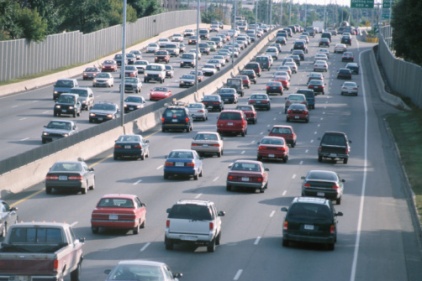 Posted with permission from Fairwarning.org:
Posted with permission from Fairwarning.org:
A Swedish study has found that drivers take long gazes at electronic billboards, possibly raising the risk of highway crashes.
The new research has put the U.S. billboard industry into a defensive mode. In an effort to dismiss the findings, the industry’s top trade group quickly cited an unpublished U.S. government study to argue that the electronic displays pose no traffic safety hazard.
But as FairWarning reported last February, publication of the federal study has been delayed indefinitely because expert reviewers concluded that its key findings were not believable.
Even so, the Outdoor Advertising Association of America, in a statement issued last week, cited the botched research by the Federal Highway Administration as evidence the new Swedish study “has little relevance to billboards in the United States.” The statement adds: “In February 2012, the Federal Highway Administration (FHWA) made information about its research available….These documents indicated that drivers’ attention is drawn to digital billboards for periods of time ‘well below’ safety thresholds.”
The Swedish study, published online by the journal Traffic Injury Prevention, will be presented this week in Washington D.C. at the annual meeting of the Transportation Research Board, part of the National Academy of Sciences. Jerry Wachtel, a traffic safety expert who chairs a panel that will hear the presentation, criticized the industry for citing the flawed FHWA research to debunk the Swedish findings.
“I think it is not only dishonest, but I think it is intentionally dishonest,” Wachtel said.
Nicole Hayes, spokeswoman for the Outdoor Advertising Association, declined comment on Wachtel’s remarks, but defended her group’s statement about the government research. In the past, Wachtel has been critical of some industry-sponsored studies, and the Outdoor Advertising Association has accused him of holding an anti-billboard bias.
With billions of dollars potentially at stake, billboard companies have been making an aggressive push to install more of the lucrative, eye-grabbing electronic signs, which typically flash a new message every six to eight seconds. Of more than 400,000 billboards in the U.S., estimates of digital displays range from about 2,000 to as many as 3,200. Billboard opponents, who long have attacked traditional billboards as unsightly, have seized on the issue of driver distraction to fight the spread of electronic signs.
The Swedish billboard study used sophisticated eye-tracking equipment to measure the time drivers gazed at electronic billboards and at conventional highway signs. The 41 participants drove a route in Stockholm that included four electronic billboards and seven other signs. The researchers found that glance times at digital billboards were “significantly longer” than at other signs. In some cases, drivers stared at the electronic displays for more than two seconds—a length of time that some research has linked to a higher crash risk.
The study reached no conclusion on whether digital signs are actually dangerous. “Our data show that the electronic billboards, in fact, attract more glances than the other signs,” it says. “This clearly indicates that they do what they are built for. Whether they attract too much attention and constitute a bona fide traffic safety hazard cannot be answered conclusively based on the present data.”
“This study validates what is common sense when it comes to digital billboards,” said Mary Tracy, president of Scenic America, an anti-billboard group. “Bright, constantly changing signs on the side of the road are meant to attract and keep the attention of drivers, and this study confirms that is exactly what they do.”
The U.S. research cited by the industry was announced five years ago, and had been eagerly awaited by state and local officials and other players involved in the debate over the impact on traffic safety. Like the Swedish study, it involved measuring the eye movements of drivers along prescribed routes in Reading, Pa., and Richmond, Va., featuring both electronic and static signs.
Originally scheduled to be completed in 2009, the draft study was submitted by an FHWA contractor in September, 2010, and circulated for internal review, according to documents obtained by FairWarning under the Freedom of information Act.
Twice in 2011, FHWA officials were scheduled to present the findings at transportation conferences but begged off without explanation.
According to agency documents, the eye-glance times recorded in the study were so brief that the experts — identified only as “REVIEWER 1″and “REVIEWER 2″— said they were unbelievable.
“The reported glances to billboards here are on the order of 10-times shorter than values reported elsewhere,” one reviewer wrote. “The pattern of results certainly raises questions over the quality and legitimacy of the underlying data.”
Said the other: “The data reported as average glance durations are not possible.”
In defending the industry statements about the FHWA research, Hayes of the Outdoor Advertising Association cited internal agency memos that FairWarning posted on its website last February. The memos summarized measurements showing that glances of drivers away from the road were extremely brief, and therefore below levels deemed unsafe. However, those were the glances that the expert reviewers said were too short to be accurate.
FHWA officials last year told FairWarning that their study remained under internal review, and that they still hoped to publish it. In an email last week to FairWarning, agency spokesman Doug Hecox said “a publication date has not yet been set.”
Posted in Auto and Highway Safety, FairWarning Reports
About FairWarning
FairWarning (www.fairwarning.org) is a nonprofit, online news organization focused on issues of safety, health and government and business accountability.

 Myron Levin founded FairWarning after more than 20 years as a staff writer for the Los Angeles Times, where he was a member of the California investigations desk. He has won numerous honors and awards for his detailed investigations of health and safety matters, including an Alicia Patterson Foundation fellowship and the National Press Club’s Consumer Journalism Award. He has reported on the tobacco industry, auto and tire safety, and a variety of product liability issues. He likes hiking and playing racquetball, and he owns a minuscule share of a professional minor league baseball team. Myron is a member of FairWarning’s board of directors.
Myron Levin founded FairWarning after more than 20 years as a staff writer for the Los Angeles Times, where he was a member of the California investigations desk. He has won numerous honors and awards for his detailed investigations of health and safety matters, including an Alicia Patterson Foundation fellowship and the National Press Club’s Consumer Journalism Award. He has reported on the tobacco industry, auto and tire safety, and a variety of product liability issues. He likes hiking and playing racquetball, and he owns a minuscule share of a professional minor league baseball team. Myron is a member of FairWarning’s board of directors.



